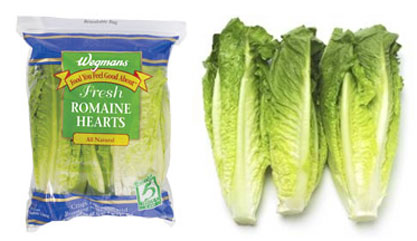A few weeks ago I received an e-mail from a major chain asking me to post an article about the proper sampling procedures for Romaine Hearts. They were concerned because they were finding the USDA inspectors were not being consistent, from DC to DC.
For example, some USDA inspectors were inspecting the entire carton of Romaine Hearts, opening up every consumer package, inspecting every romaine plant. Other USDA inspectors were only inspecting one or two consumer packages, ignoring the romaine in the rest of the carton. And even others were opening enough consumer bags to make a sample size of 15 plants. So what is the correct procedure?
The confusion is very surprising because there are written instruction procedures for the proper sampling of Romaine Hearts in the USDA Inspection Instructions for Lettuce. The instructions state: “The total number of plants in the container shall be the sample size. However, if the plants are in consumer type packages, with 2 or more plants in a package within master containers, the consumer package will be the unit of sample. Bag or wrapping material must be completely removed from the sample plants in order to determine the presence or absence of defects.”
To summarize, if the Romaine Hearts are packed in a consumer package, having at least two plants, you would open up the package and inspect the plants. For example, if your consumer bag has three plants, as pictured above, your sample size would be 3. If one of the plants had decay, you would have 33% (1 out of 3) decay for that sample. You would inspect two to three consumer bags per master.
You would want to look at least three masters for a quick inspection, meaning you would have 9 samples in total on your notesheet, assuming you inspected three consumer bags per master. If you had one plant (33%) with decay, in your first sample, and no other defects in the remaining samples, you would have 4% decay for the lot.
I hope I cleared this up a little. If I totally confused you with the percentages and sample sizes, etc, maybe this light-hearted video will help you with the formulas used in determining percentages. Click on the: Produce Math Video


One Comment on “Romaine Hearts- Sampling”
I am confused as to why you would inspect 3 masters from a single carton? A better representation for any lot or load of romaine hearts would be to sample 1 consumer unit from separate cases. For example lets say you had 24 pallets at 56 cartons per pallet you would have 1344 master cartons. USDA sates a minimum of 1% of the load so 13 samples total, but since you are dealing with a consumer package containing usually 3 (or in some cases 6 heads) either way you should DOUBLE your sample size to 26 individual master packages now correct? I believe this is the proper sampling technique and procedure for the USDA. This would ensure that 1 consumer unit from every pallet has been examined with few pallets consisting of a double sample that should still be obtained from a separate carton. If you inspected your samples as stated above looking at 3 consumer units per carton your inspection would be based off of 9 pallets at best (27 samples). This hardly represents a true inspection for the load. Whenever dealing with samples that can fail so easily (33.3% for 1 defective head) extra care and proper grading techniques should be taken. Also shippers and receivers should be aware that 1 defective head is permitted per sample so ranges stating 0-33% defective / 0-17% (when dealing with 6 heads) does not exceed application of tolerance and in permitted provided that your total checksum is still in grade.